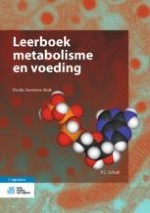Samenvatting
Hoofdstuk 1 bespreekt de structuur en functie van de belangrijkste biomoleculen. Eerst bekijken we de koolhydraten (suikers), die goede brandstof zijn maar ook uitblinken als structuurgevende moleculen. De tweede groep zijn de lipiden (vetten), die met hun apolaire groepen grenzen vormen in een ‘levende waterwereld’ (biologische membranen). Vetten leveren tevens uitmuntende brandstof. De derde groep biomoleculen bestaat uit proteïnen (eiwitten), die opgebouwd zijn als een ketting van twintig soorten aminozuren. Proteïnen staan centraal in het uitvoeren van metabole functies, zoals enzymen, hormonen en receptoren. De vierde groep biomoleculen bestaat uit informatiedragende nucleïnezuren RNA (ribonucleïnezuur) en DNA (desoxyribonucleïnezuur). DNA bevat de erfelijke informatie die de eiwitten coderen om een mens te laten functioneren; RNA is de vanuit DNA afgeschreven informatie die een interface maakt tussen DNA en eiwitten.

